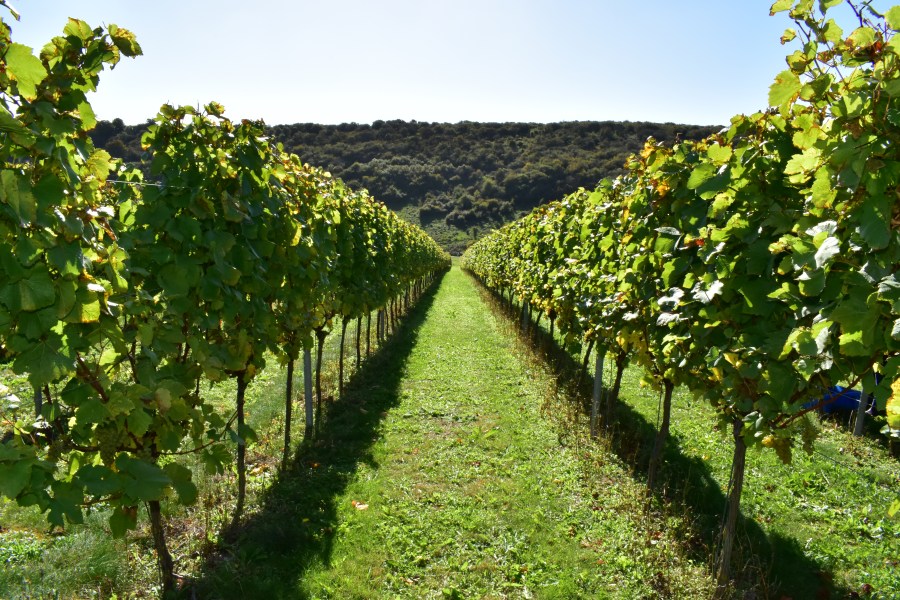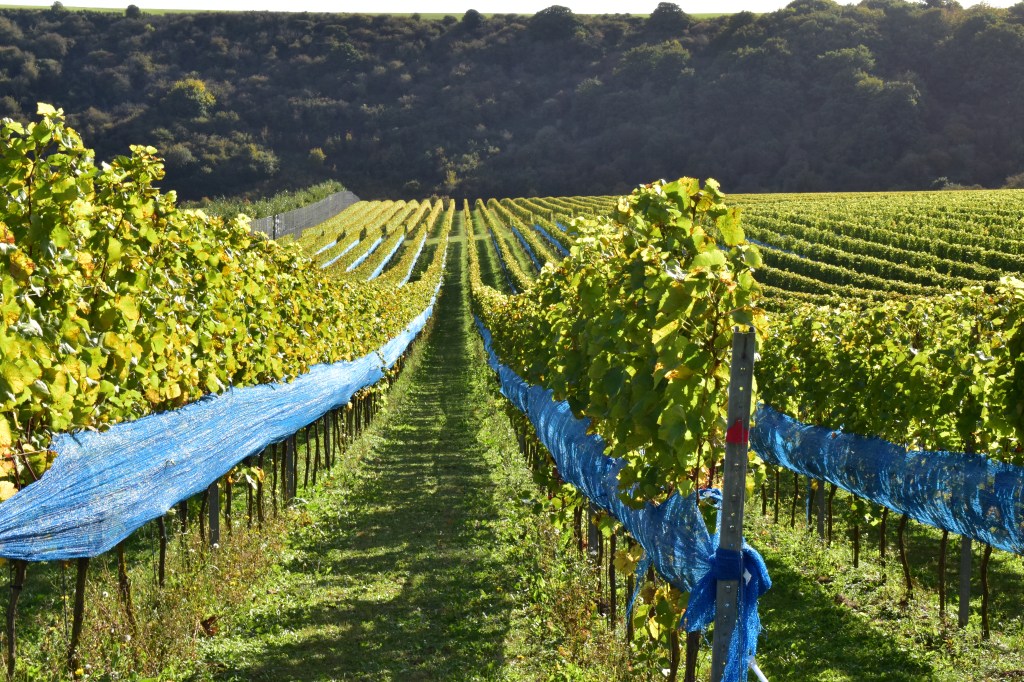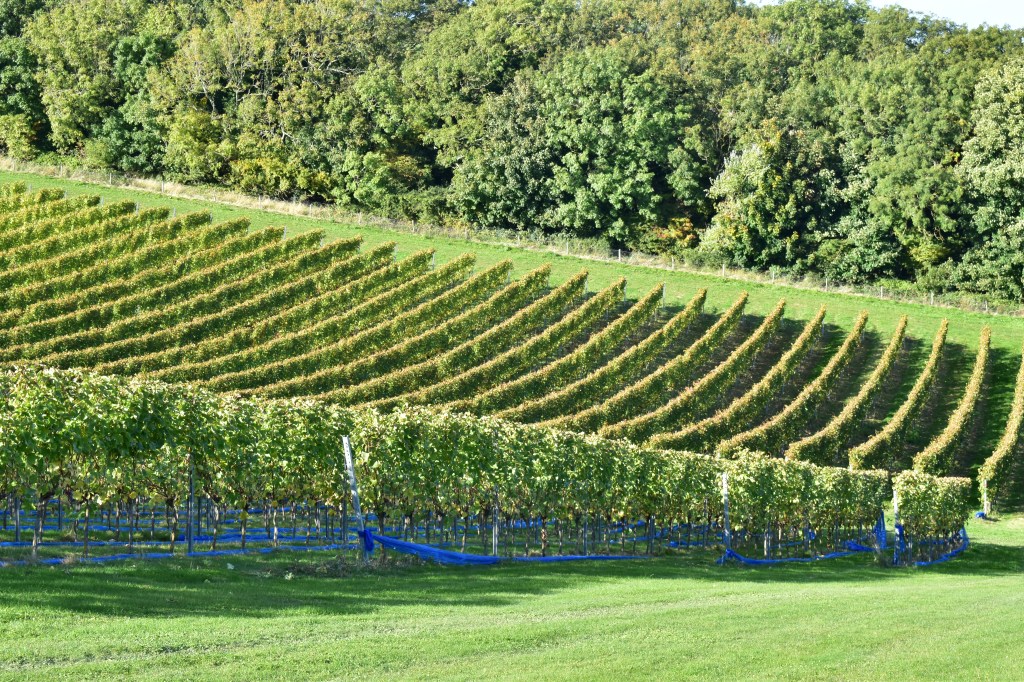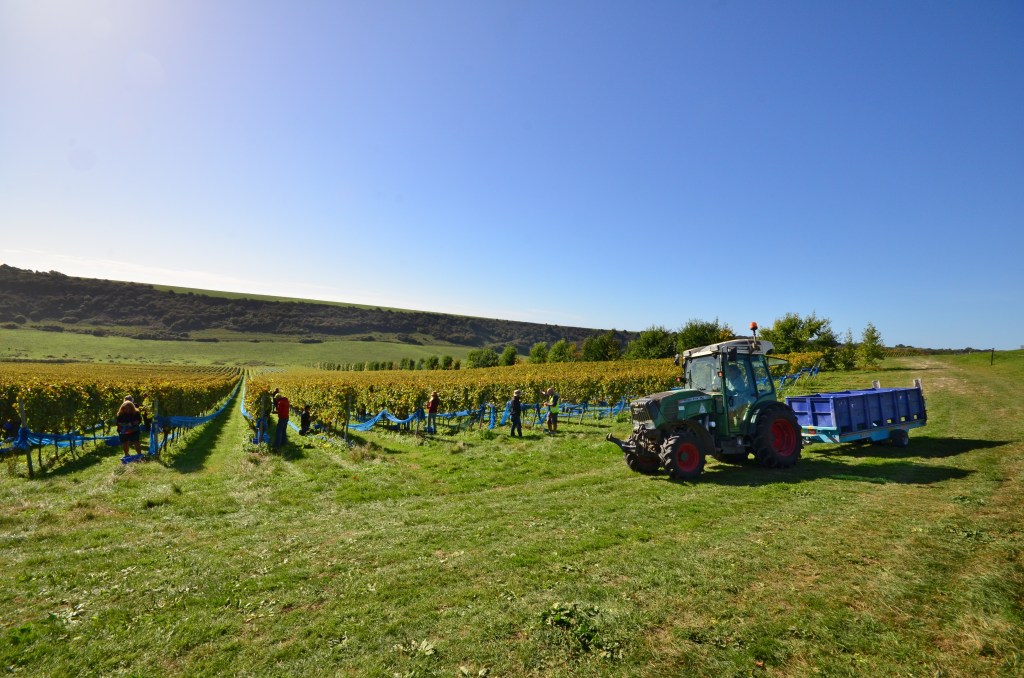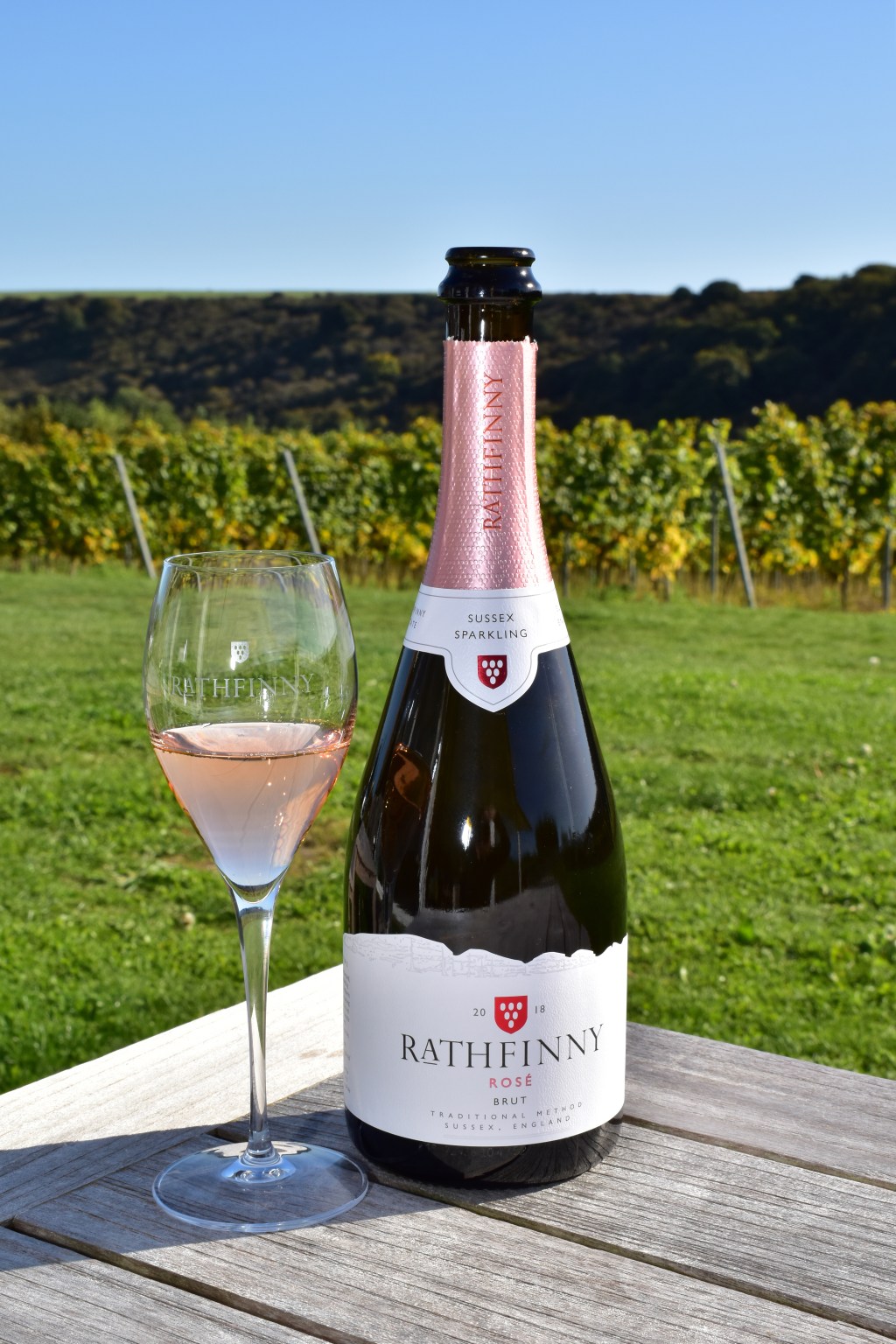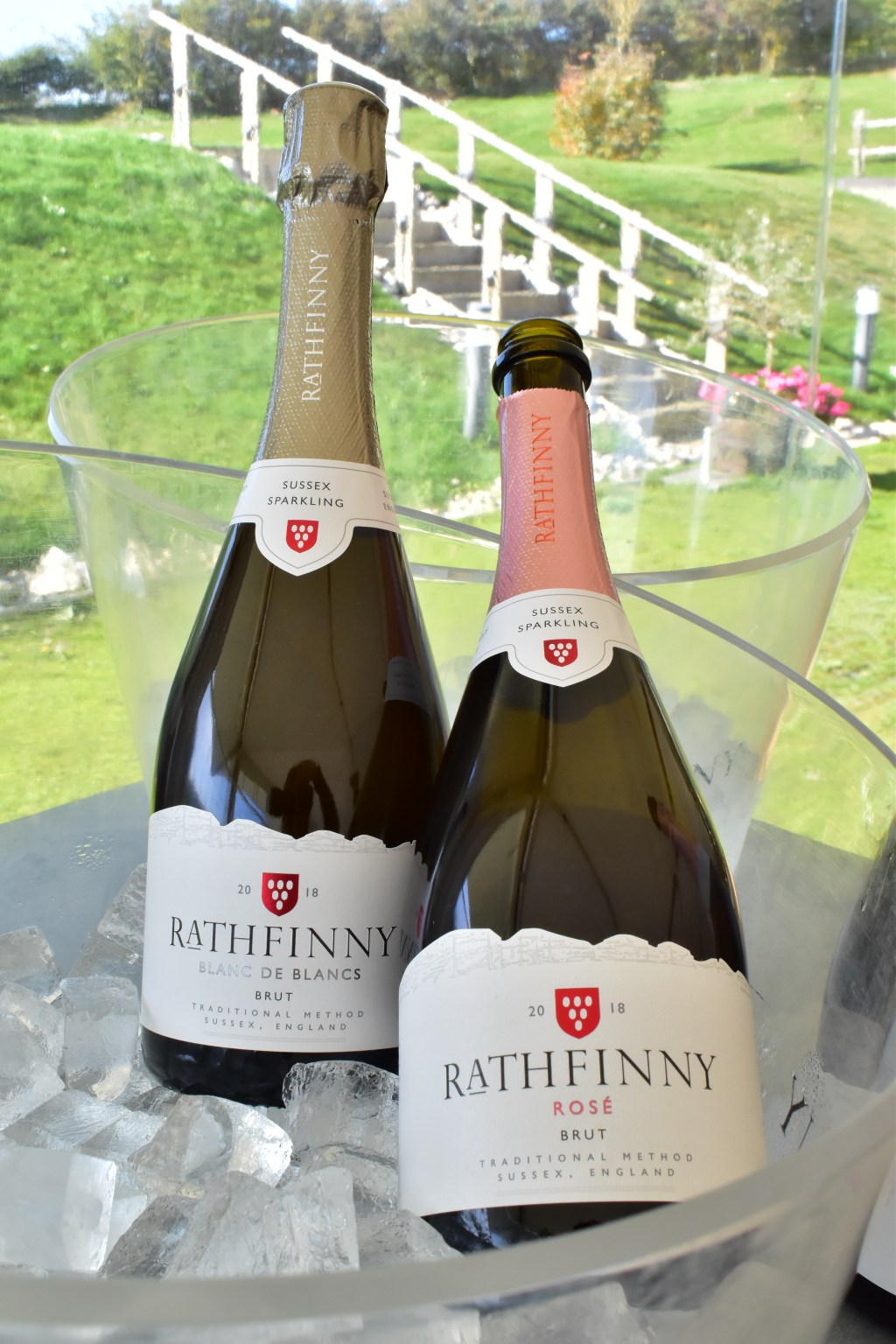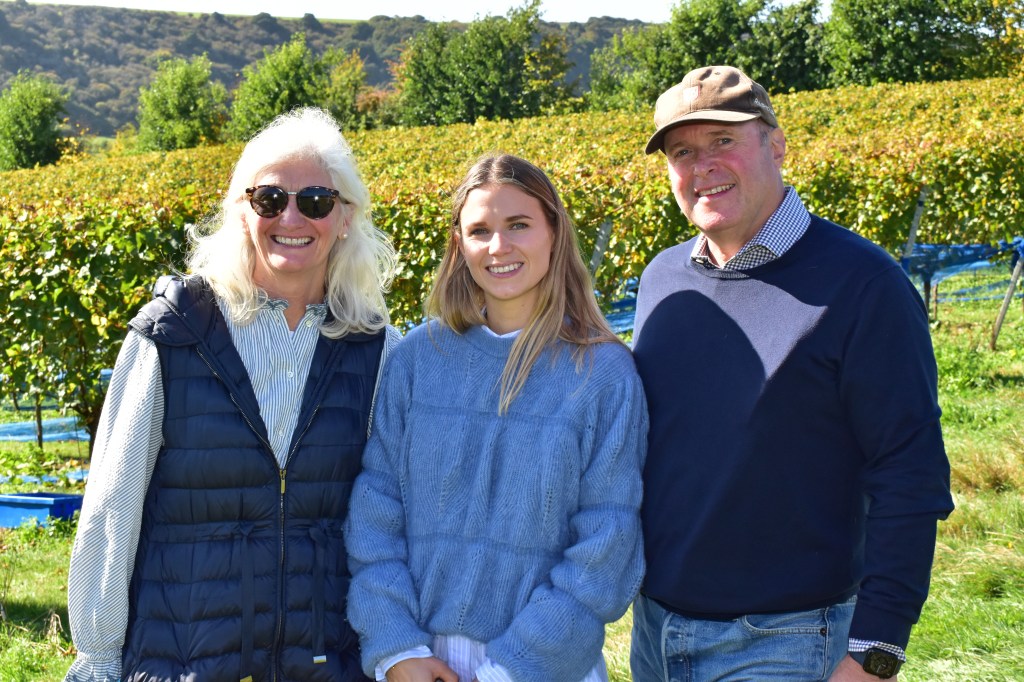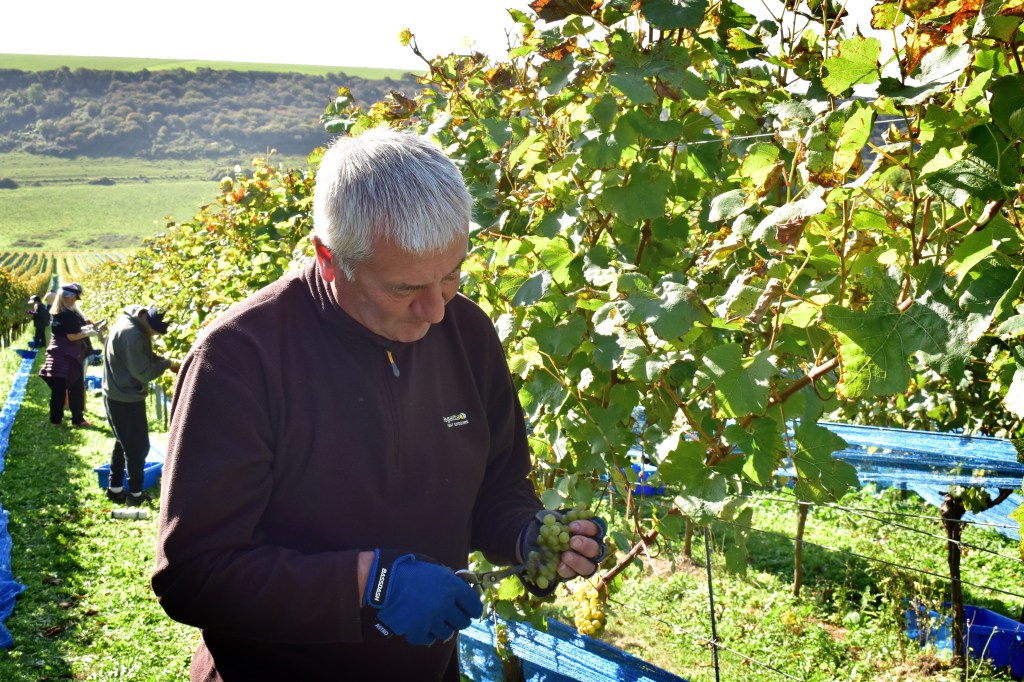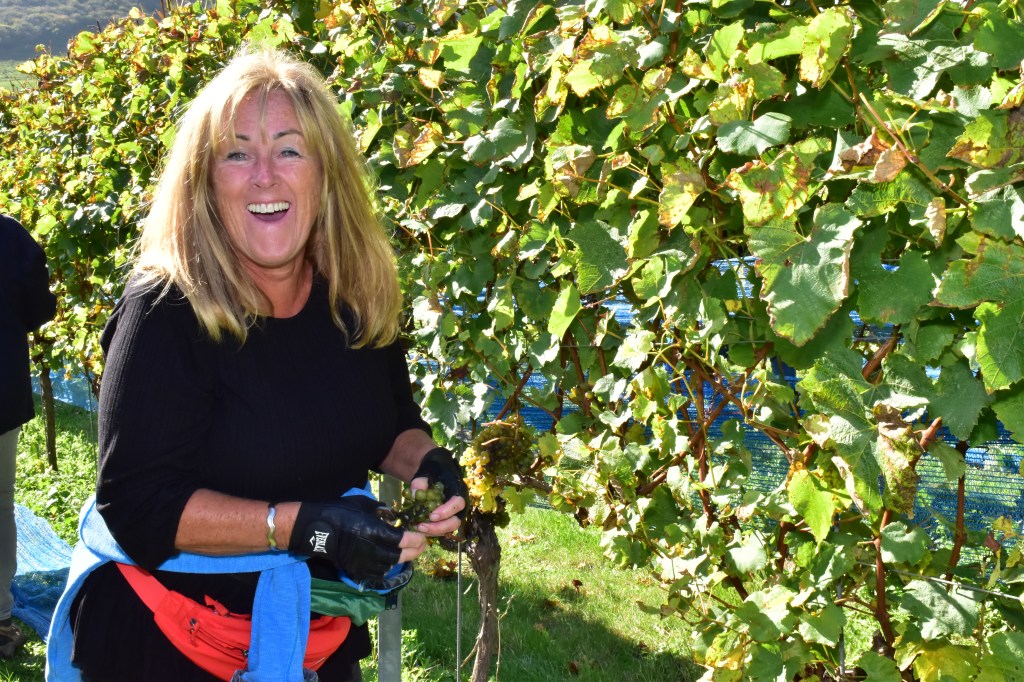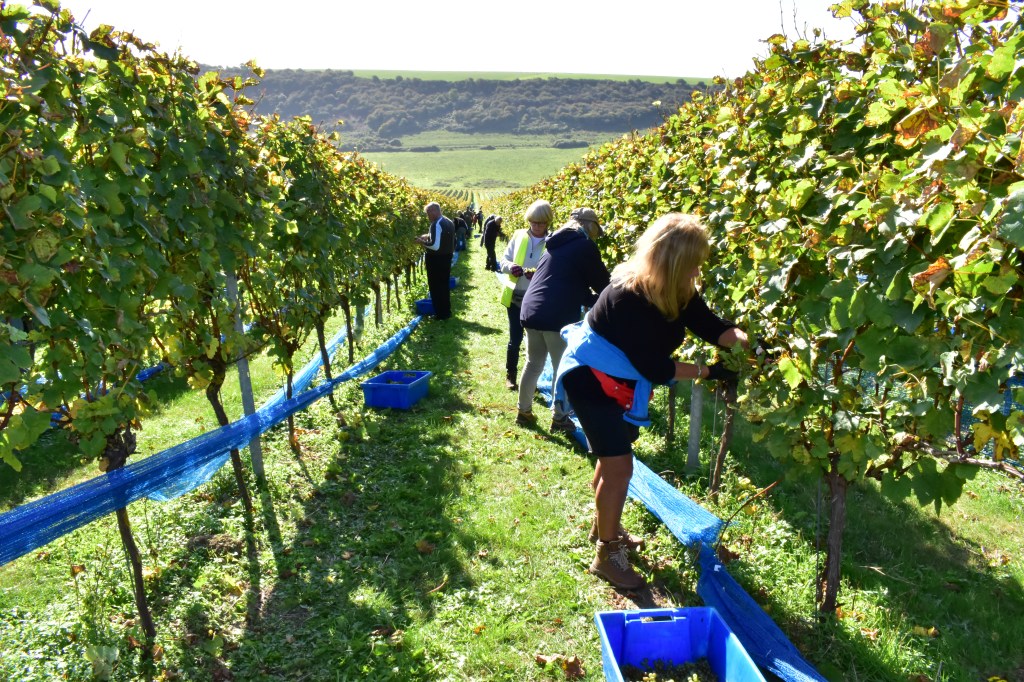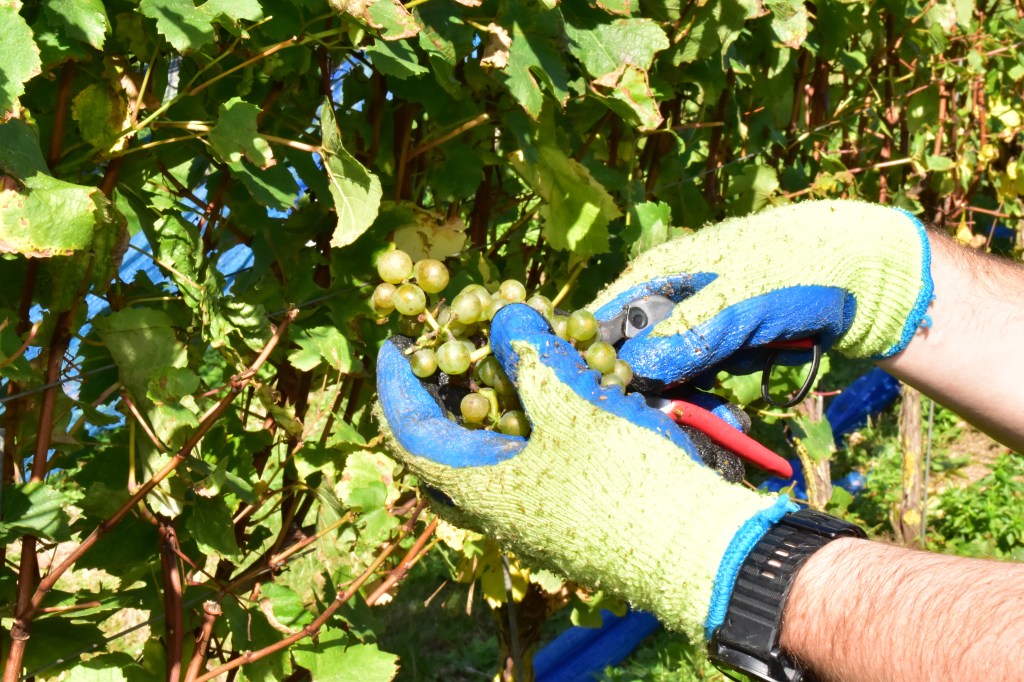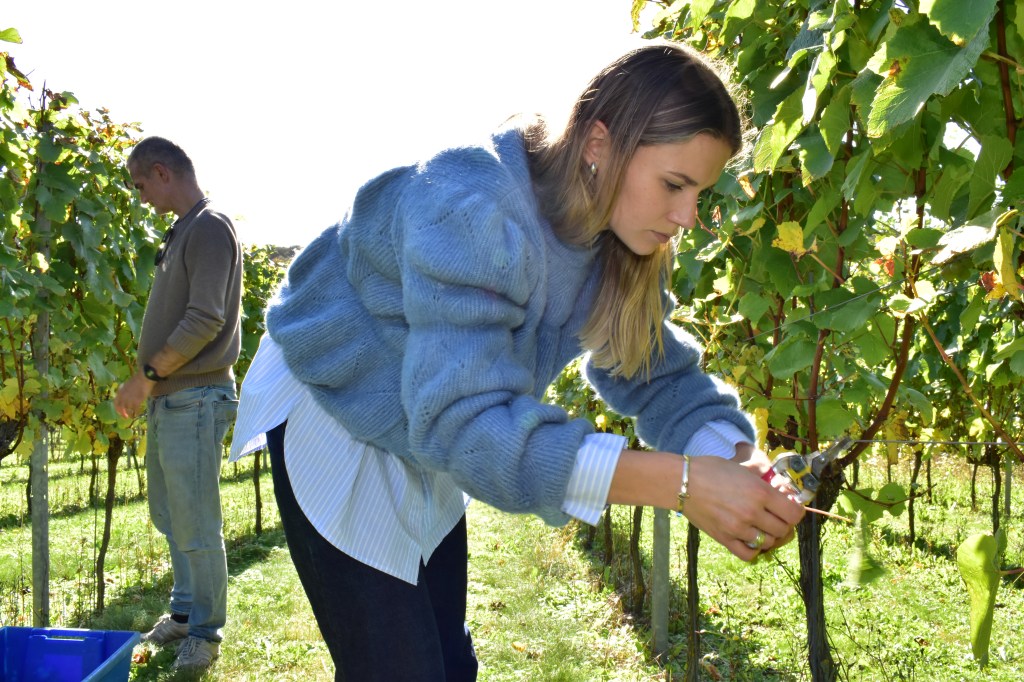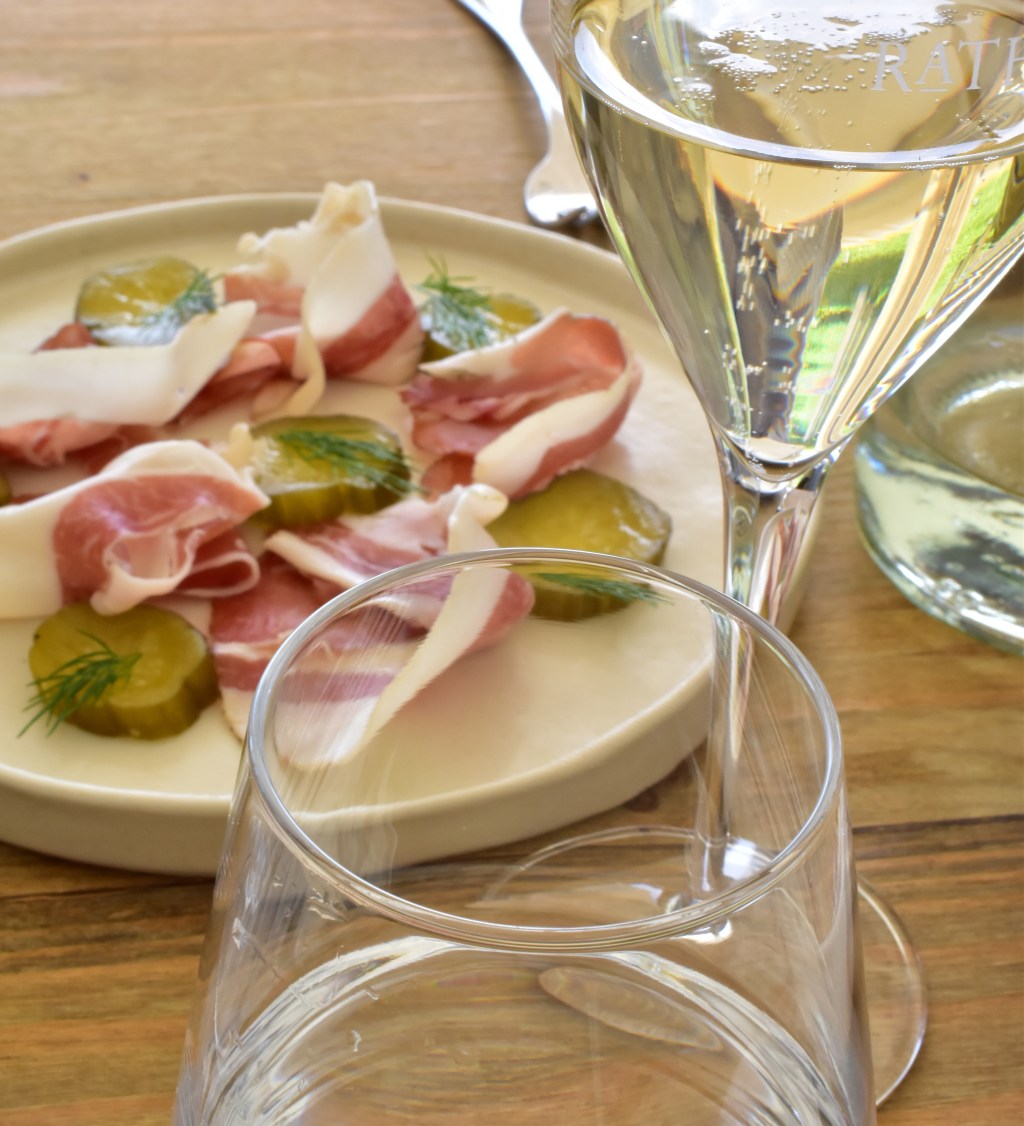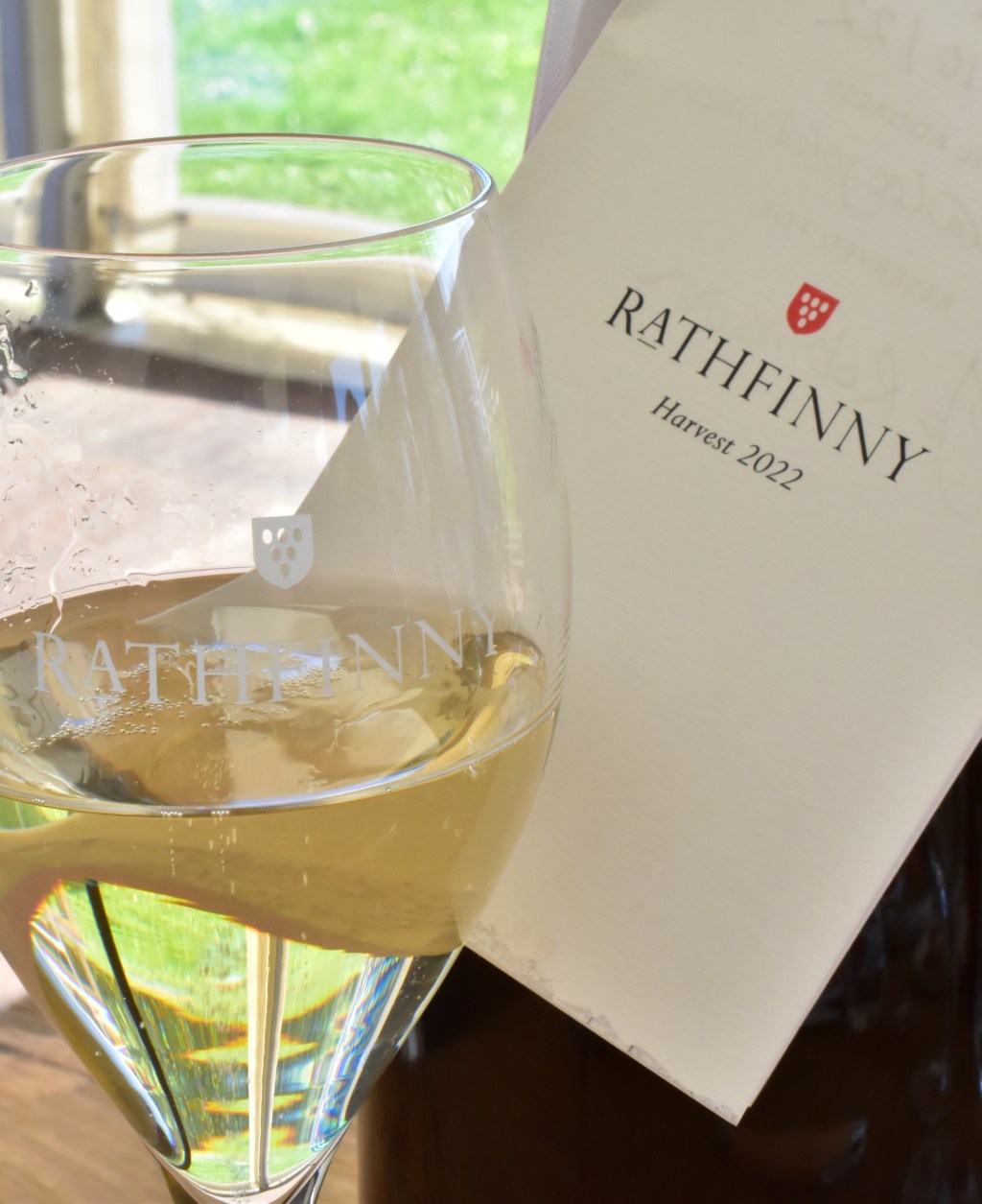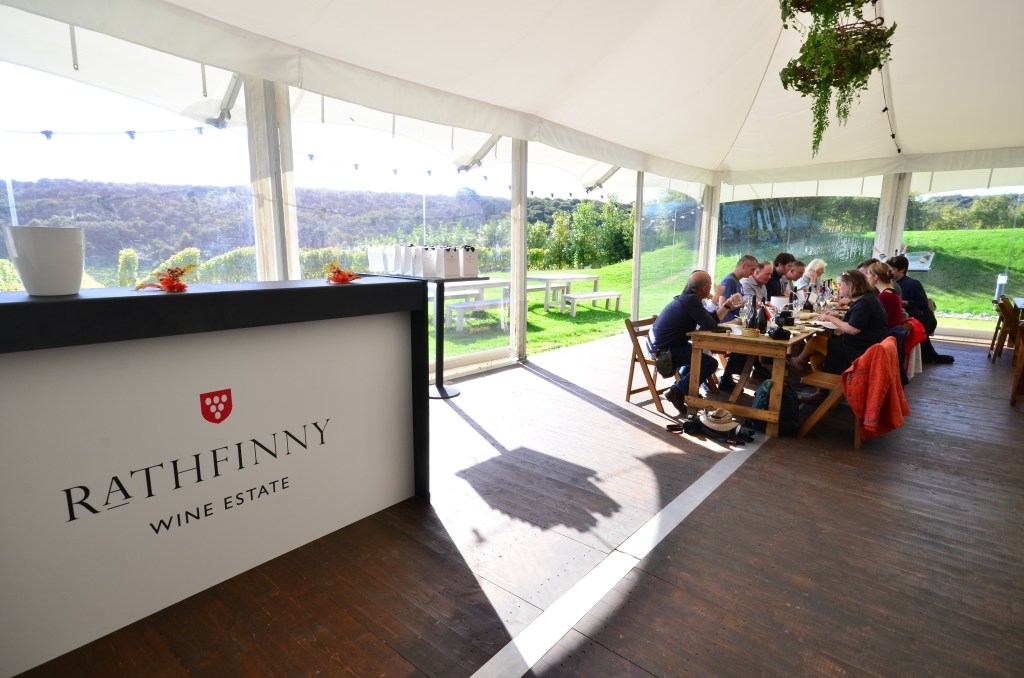It is difficult to describe Rathfinny Wine Estate. The word beautiful seems so understated but then the quiet elegance of the whole enterprise has a feeling of understated excellence. A label is a necessary part of any bottle of wine but Rathfinny uses the picturesque backdrop of the Severn Sisters cliffs to give an unusual, quirky and yet sophisticated twist to this necessity.
The path to the flint barns takes visitors past thousands of vines. This is a sight more common in the Alsace and Provence but not traditionally seen in Sussex. I ask Mark Driver the co-owner of Rathfinny Wine Estate what has changed in the three years since my last visit and he explained: “The young vines planted three years ago are now coming on stream; about 40 hectares.” This means that Rathfinny has 380,000 vines across 93 hectares at a density of 4,100 vines per hectare. Some of the more unusual aspects of the vineyard are the “clonal varieties such as 1067 Burgundy clone for chardonnay which is low yield but will produce deep rich muscat flavours,” said Mark.
Vineyard magazine and other members of the press were invited to witness harvest at Rathfinny Wine Estate. Using a local workforce to hand pick all the grapes on the estate Rathfinny operate a scheme that allows people to register their interest to take part in this special event. The scheme provides the 200 paid workers needed to complete the harvest over a three week period. The scheme has been in place since 2014 and is very often oversubscribed.
Talking to some of those who are part of the teams that will pick around 30 tonnes of grapes each day it is clear that people have varied reasons for becoming part of the Rathfinny harvest. Pickers are split into teams and assigned a team leader who provides training and supervision. One young worker explained that he had finished college and before taking a gap year had taken this job picking grapes describing it as “the best job in the world.” Mark and Sarah Driver are both passionate about encouraging young people into the industry. However it is not just young people who are working amongst the vines at Rathfinny. One man is quite poetical about his reasons for joining the harvest team declaring: “Retirement is about having choices.” The eclectic mix of workers at Rathfinny include many who return year after year adding to their skillset as they go. “We even had a wig-mistress join the team,” said Sarah Driver co-owner of Rathfinny.
At a time when many within agriculture not just viticulture are increasingly worried about sourcing a workforce to harvest everything from Asparagus to Zucchini, Rathfinny have taken a path that provides a solution that insulates them from these long term worries about labour shortages as well as connecting them to the local community, given that most of the harvest team members come from within a 10 mile radius.
Talking in the vineyard in early October on what was an unseasonably hot day, Mark pointed out that the location of the vineyard, just a few miles from the coast means that the vines are well protected from frost “sea proximity provides protection,” he said. At its best the vineyard will “produce eight tonnes per hectare but this year will produce five tonnes per hectare,” Mark added.
“The grapes are being harvested at about 19 Brix which should give about 10.5% alcohol,” Mark told the assembled journalists. The way Rathfinny harvest their grapes ensures that the grapes are picked at exactly the right time. Each week each block is analysed by taking random bunches and testing for sugar and acidity. The harvest team are ready as soon as the grapes are.
The collection and use of statistics does not stop at harvest. The weights of canes left on the vines are taken and recorded to see how much carbohydrate has been left on the vine to give an indication of vine strength. “This information is then used to work out how many buds to leave on the vines,” said Mark. For example 2021 had been a particularly tricky year for powdery mildew, not just here in the UK, so this cane analysis helped the vineyard team make a tough decision. “This year 30% less buds were put out,” said Mark. Vineyard manager Cameron Roucher a Nuffield scholar “made the suggestion not just for the health of the vines this year but for the health of the vines going forward,” explained Sarah Driver. “Reducing the buds this year has prevented over stressing the vines,” added Mark. “In an ideal year we leave 12-14 buds but this year we were leaving just eight,” he explained. Working in an industry that is so reliant on the weather will always mean that there are bad years but Mark said: “2021 was a bad year for us but we had four very good years prior to that.”
To protect the vineyard from pests the whole vineyard is netted just past veraison. It takes the in-house team about two weeks to cover the entire vineyard. Millie Driver, Director of Marketing at Rathfinny reveals something that you instinctively feel when you visit Rathfinny. There is a feeling of peace and tranquillity as soon as you enter the Estate something that benefits the walkers who can follow a route along the cradle valley and through the vineyard but beyond this Rathfinny has a sense of harmony. It was not until Millie explained that in the summer some of the in-house team of vineyard workers would take a 15 minute drive to the sea for a swim in their lunch break that I realised what I had been feeling for the whole of my visit – a sense of teamwork and respect that pervaded every part of the business. All parts of the estate complement each other with the production of great wine at the centre.
Rathfinny use a low intervention technique in their wine making and try to express the fruit flavours in the wines. The Estate produces a Classic Cuvée, Rosé, Blanc de Blancs and Blanc de Noirs which Mark declared was his favourite and Sarah said was their signature wine. The 2018 Blanc de Noirs contains 85% Pinot Noir with 15% Meunier and is low dosage at 3.5g/litre. Under the Cradle Valley label the estate also produces still wines sold on the estate and in the restaurant. Mark explained: “All the wines we produce are vintage. Each of the blocks and clones are picked separately, then fermented and vinified separately allowing for greater blending capabilities in March of the following year.” When talking about why Rathfinny choose to produce vintage rather than non-vintage wines Mark explained: “I just love to celebrate a vintage reflecting the production for that year. We can control the quality because we control the whole production process.”
It is clear that quality is key at Rathfinny and Mark Driver explained that was the motivation for the establishment of the Sussex PDO which was granted in July 2022 after what was an “eight year effort,” said Sarah. Wines labelled as Sussex must fulfil certain criteria and under the UK GI scheme are afforded legal protection. Some of the regulations require the wines to be submitted to an independent tasting panel, have a minimum bottle aging of 15 months and the grapes must have been harvested by hand (special dispensation is available only in the event of exceptional circumstances). Mark explained the Sussex PDO is all designed to protect a premium product, guarantee quality and provinence. “English sparkling wine is a clunky description and is not a quality mark,” he added.
Rathfinny is a business that has no intention of standing still. Taking a path towards greater sustainability Rathfinny are working towards B Corp Certification – a process that takes into account the whole impact of a business on its surroundings including the local community and workers as well as the environment. The company mission statement declares: “We are committed to producing exceptional wines and experiences, enjoyed the world over, that reveal the character of our family estate in Sussex, using methods that are kind to our land, people, community and wider environment.”
This is an approach that covers everything in the business and Rathfinny have successfully implemented new technologies to enable them to become kinder to the environment. However “there are sometimes unintended consequences,” said Sarah. In a move towards encouraging beneficial insects to the vineyard and increasing biodiversity at the same time as reducing tractor miles Rathfinny were allowing more growth between the vines but later in the season it became apparent that the vineyard workers were suffering from this greater biodiversity. “One of the vineyard supervisors contacted me directly and said the insects are ‘killing’ us,” explained Sarah. The growth between the rows had attracted so many insects the workers were being bitten and were also getting very wet from all the moisture! So to mitigate this effect on their workers Rathfinny are investing in a crimper that will flatten the grass down instead of cutting it.
Another direction along the unique road that the Rathfinny Wine Estate is taking is the production of 50cl bottles. Magnums of English Sparkling Wine are increasingly seen but currently Weights and Measures legislation prevents the sale of 50cl bottles of wine. Mark Driver explained why he felt a 50cl bottle would be positive for the industry: “Half bottles of sparkling wine are an inferior product, too small (only three glasses) and very expensive. A 50cl bottle provides two glasses each as opposed to three glasses from a half bottle.” This definitely makes a 50cl better for sharing and creates a better experience.
This conversation about the 50cl bottle leads to the thought of wine tourism and Rathfinny has a fantastic offering for visitors and tourists. Rathfinny Wine Estate welcomes 60,000 visitors a year and their guest rooms are fully booked three to four months in advance. The Estate will also bring whole teams from restaurants to the vineyard to encourage enthusiasm amongst the on-trade. “A lot of the visitors who come for lunch are very knowledgeable and will visit other vineyards in the area as well,” Sarah commented. The restaurant at Rathfinny which has a listing in the Michelin Guide serves exquisite local food under the direction of chef Chris Bailey and in the courtyard outside there is a hut (the Hut) that caters for visitors who just drop by. The location of Rathfinny within Sussex provides a plethora of local produce from seafood to Pevensey Blue cheese ensuring the restaurant benefits from the finest produce.
Sarah explained that: “Wine tourism is about the experience.” She went on to explain that she had visited South Africa with Mark for the purpose of researching the installation of a waste water plant back in the UK. During this research trip they also visited 15 South African vineyards in depth and behind the scenes and she described this experience as a “lightbulb moment.” It was at this point that Sarah realised that she wanted to create “the complete experience” for all their visitors. Sarah explained that when they first started to welcome visitors, “the big education piece was about sparkling wine and how it is made and why we (in the UK) are so good at it and the meaning of the traditional method but now the education piece has changed and we are talking vintages and what is a Blanc de Blancs and what is a Blanc de Noirs?” English and Welsh wine as a category is still growing and developing hopefully this dialogue will continue to evolve as the industry works together at the conversation.
“On the tourism side there is also Sussex Modern which Mark is heavily involved with; it is a collaboration between art galleries and wineries in Sussex,” Sarah explained. “The idea is that you can join the dots. You can say I would like to go to a vineyard in the morning, I would like to have lunch somewhere and then I would like to go to the Towner gallery and then Ditchling museum. I really do believe we will become like Margaret River, (the Australian region has a unique tourist offering)” Sarah added before going on to quote a very surprising statistic. “96% of people who land at Gatwick go north,” she said. This clearly highlights the importance for all tourism businesses of attracting visitors to the region and the potential part that all rural businesses can play in this.
Sarah stated that as a business they had seen an increase in the range of international visitors hosting tourists from “Scandinavia, France and even Canadian visitors who said they had come to see the Sussex wine lands.” This increase in international travellers is important for the industry on a wider scale Sarah explained. Research released in New Zealand indicates that domestic wine tourists spend 32% more than an average tourist but an international wine tourist spends 80% more.”
It is not just the on-trade where the Rathfinny label has been noticeable. Since their maiden vintage was released in July 2018 it is a label that has become very prominent in independent wine and speciality retail. Back in 2019 Mark said: “We know that our wine is not going to sell sitting on the shelf of a big grocery store because as a premium product it has to be hand sold.” This idea of the personal touch flows right through the whole business and whilst taking the route back along the winding pathway with vines on either side the visitor is left with the sense of having been somewhere special, having been treated as someone special and possibly if you have picked up a bottle or six from the cellar door you feel like you will be taking something a bit special home with you.

